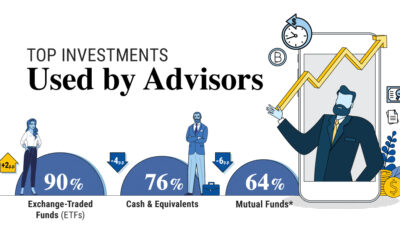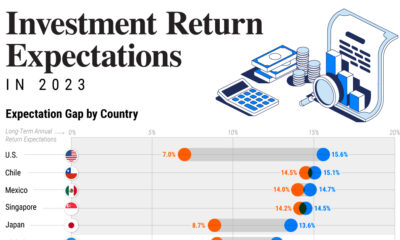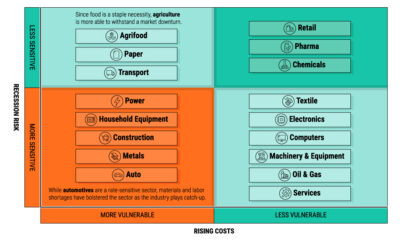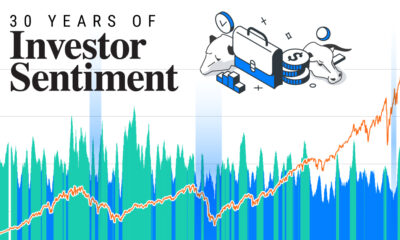This infographic is available as a poster.
Visualizing Three Types of Inflation
Inflation is dominating the news as prices hit 40-year highs.
While the price of everyday goods, including food and energy, is the most widely cited type of inflation, other forms exist across the broader economic system.
In this Markets in a Minute from New York Life Investments, we chart three types of inflation and the macroeconomic factors that influence each type.
1. Monetary Inflation
Monetary inflation occurs when the U.S. money supply increases over time. This represents both physical and digital money circulating in the economy including cash, checking accounts, and money market mutual funds.
The U.S. central bank typically influences the money supply by printing money, buying bonds, or changing bank reserve requirements. The central bank controls the money supply in order to boost the economy or tame inflation and keep prices stable.
Between 2020-2021, the money supply increased roughly 25%—a historic record—in response to the COVID-19 crisis. Since then, the Federal Reserve began tapering its bond purchases as the economy showed signs of strength.
| Year | Money Supply | Annual Percent Change |
| 2022* | $21.7T | 0.9% |
| 2021 | $21.5T | 12.6% |
| 2020 | $19.1T | 24.8% |
| 2019 | $15.3T | 6.3% |
| 2018 | $14.4T | 3.6% |
| 2017 | $13.9T | 5.3% |
| 2016 | $13.2T | 7.3% |
| 2015 | $12.3T | 5.1% |
| 2014 | $11.7T | 6.4% |
| 2013 | $11.0T | 4.8% |
| 2012 | $10.5T | 8.2% |
| 2011 | $9.7T | 10.2% |
| 2010 | $8.8T | 6.0% |
| 2009 | $8.3T | 1.2% |
| 2008 | $8.2T | 9.3% |
| 2007 | $7.5T | 5.6% |
| 2006 | $7.1T | 6.0% |
| 2005 | $6.7T | 4.7% |
| 2004 | $6.4T | 4.9% |
| 2003 | $6.1T | 5.2% |
| 2002 | $5.8T | 7.4% |
| 2001 | $5.4T | 10.2% |
| 2000 | $4.9T | 6.5% |
| 1999 | $4.6T | 4.5% |
| 1998 | $4.4T | 10.0% |
| 1997 | $4.0T | 5.3% |
| 1996 | $3.8T | 5.6% |
| 1995 | $3.6T | 2.9% |
| 1994 | $3.5T | 0.0% |
| 1993 | $3.5T | 2.9% |
| 1992 | $3.4T | 0.0% |
| 1991 | $3.4T | 3.0% |
| 1990 | $3.3T | 3.1% |
| 1989 | $3.2T | 6.7% |
| 1988 | $3.0T | 7.1% |
| 1987 | $2.8T | 3.7% |
| 1986 | $2.7T | 8.0% |
| 1985 | $2.5T | 8.7% |
| 1984 | $2.3T | 9.5% |
| 1983 | $2.1T | 10.5% |
| 1982 | $1.9T | 5.6% |
| 1981 | $1.8T | 12.5% |
| 1980 | $1.6T | 14.3% |
| 1979 | $1.4T | 0.0% |
| 1978 | $1.4T | 7.7% |
| 1977 | $1.3T | 8.3% |
| 1976 | $1.2T | 20.0% |
| 1975 | $1.0T | -99.9% |
| 1974 | $902B | 5.4% |
| 1973 | $856B | 6.7% |
| 1972 | $802B | 13.0% |
| 1971 | $710B | 13.2% |
| 1970 | $627B | 6.6% |
Indicated by the M2 Money Stock.
*Data as of April 2022.
It’s worth noting that, in theory, increasing the money supply faster than the growth in real output may cause consumer price inflation, especially if the velocity of money (speed at which money exchanges hands) is high. The reason is that there is more money chasing the same number of goods, and this eventually leads to increases in prices.
2. Consumer Price Inflation
Consumer price inflation occurs when the prices of goods and services increase. It is typically measured by the Consumer Price Index (CPI), which shows the average price increase of a basket of goods, such as food, clothing, and housing.
Supply chain issues, geopolitical events, monetary supply, and consumer demand may all affect consumer price inflation.
Rising 8.6% in May year-over-year, the CPI hit its highest level in four decades. Russia’s invasion of Ukraine and COVID-19 have caused extensive disruption in supply chains, from oil to wheat, leading to increased price pressures worldwide.
| Year | CPI Annual Percent Change |
| 2022* | 8.6% |
| 2021 | 4.7% |
| 2020 | 1.2% |
| 2019 | 1.8% |
| 2018 | 2.4% |
| 2017 | 2.1% |
| 2016 | 1.3% |
| 2015 | 0.1% |
| 2014 | 1.6% |
| 2013 | 1.5% |
| 2012 | 2.1% |
| 2011 | 3.2% |
| 2010 | 1.6% |
| 2009 | -0.4% |
| 2008 | 3.8% |
| 2007 | 2.9% |
| 2006 | 3.2% |
| 2005 | 3.4% |
| 2004 | 2.7% |
| 2003 | 2.3% |
| 2002 | 1.6% |
| 2001 | 2.8% |
| 2000 | 3.4% |
| 1999 | 2.2% |
| 1998 | 1.6% |
| 1997 | 2.3% |
| 1996 | 2.9% |
| 1995 | 2.8% |
| 1994 | 2.6% |
| 1993 | 3.0% |
| 1992 | 3.0% |
| 1991 | 4.2% |
| 1990 | 5.4% |
| 1989 | 4.8% |
| 1988 | 4.1% |
| 1987 | 3.7% |
| 1986 | 1.9% |
| 1985 | 3.5% |
| 1984 | 4.3% |
| 1983 | 3.2% |
| 1982 | 6.1% |
| 1981 | 10.3% |
| 1980 | 13.5% |
| 1979 | 11.3% |
| 1978 | 7.6% |
| 1977 | 6.5% |
| 1976 | 5.7% |
| 1975 | 9.1% |
| 1974 | 11.1% |
| 1973 | 6.2% |
| 1972 | 3.3% |
| 1971 | 4.3% |
| 1970 | 5.8% |
| 1969 | 5.5% |
| 1968 | 4.3% |
| 1967 | 2.8% |
| 1966 | 3.0% |
| 1965 | 1.6% |
| 1964 | 1.3% |
| 1963 | 1.2% |
| 1962 | 1.2% |
| 1961 | 1.1% |
| 1960 | 1.5% |
| 1959 | 1.0% |
| 1958 | 2.7% |
| 1957 | 3.3% |
| 1956 | 1.5% |
| 1955 | -0.3% |
| 1954 | 0.3% |
| 1953 | 0.8% |
| 1952 | 2.3% |
| 1951 | 7.9% |
| 1950 | 1.1% |
| 1949 | -1.0% |
| 1948 | 7.7% |
| 1947 | 14.4% |
| 1946 | 8.5% |
| 1945 | 2.3% |
| 1944 | 1.6% |
| 1943 | 6.0% |
| 1942 | 10.9% |
| 1941 | 5.1% |
| 1940 | 0.7% |
| 1939 | -1.3% |
| 1938 | -2.0% |
| 1937 | 3.7% |
| 1936 | 1.0% |
| 1935 | 2.6% |
| 1934 | 3.5% |
| 1933 | -5.2% |
| 1932 | -10.3% |
| 1931 | -8.9% |
| 1930 | -2.7% |
*Data for 2022 shows the year-over-year change from May 2021 to May 2022.
When consumer price inflation gets too heated, the central bank may increase interest rates to curtail spending and allow prices to cool down.
3. Asset-Price Inflation
Finally, asset-price inflation represents the price increase of stocks, bonds, real estate, and other financial assets over time. While there are a number of ways to show asset-price inflation, we will use household net worth as a percentage of GDP.
Often, a low interest rate climate creates a favorable environment for asset prices. This can be seen over the last decade as low borrowing costs were met with rising asset prices and strong investor confidence. In 2021, household net worth as a percentage of GDP stood at 620%.
| Year | U.S. Interest Rate | Household Net Worth as a % of GDP |
| 2021 | 0.1% | 620% |
| 2020 | 0.1% | 510% |
| 2019 | 1.6% | 520% |
| 2018 | 2.4% | 520% |
| 2017 | 1.3% | 510% |
| 2016 | 0.6% | 490% |
| 2015 | 0.2% | 490% |
| 2014 | 0.1% | 480% |
| 2013 | 0.1% | 450% |
| 2012 | 0.1% | 430% |
| 2011 | 0.0% | 440% |
| 2010 | 0.1% | 430% |
| 2009 | 0.1% | 410% |
| 2008 | 0.1% | 460% |
| 2007 | 3.1% | 490% |
| 2006 | 5.2% | 480% |
| 2005 | 4.1% | 460% |
| 2004 | 2.0% | 450% |
| 2003 | 0.9% | 410% |
| 2002 | 1.2% | 430% |
| 2001 | 1.5% | 420% |
| 2000 | 5.4% | 440% |
| 1999 | 4.0% | 420% |
| 1998 | 4.1% | 420% |
| 1997 | 5.8% | 390% |
| 1996 | 6.3% | 390% |
| 1995 | 4.7% | 370% |
| 1994 | 4.9% | 380% |
| 1993 | 2.9% | 380% |
| 1992 | 2.7% | 380% |
| 1991 | 4.1% | 380% |
| 1990 | 5.5% | 380% |
| 1989 | 8.0% | 370% |
| 1988 | 9.0% | 370% |
| 1987 | 6.9% | 380% |
| 1986 | 14.4% | 360% |
| 1985 | 13.5% | 340% |
| 1984 | 8.7% | 340% |
| 1983 | 9.9% | 360% |
| 1982 | 11.2% | 350% |
| 1981 | 13.1% | 340% |
| 1980 | 22.0% | 330% |
| 1979 | 14.8% | 330% |
| 1978 | 10.8% | 330% |
| 1977 | 6.5% | 330% |
| 1976 | 4.2% | 330% |
| 1975 | 5.4% | 340% |
| 1974 | 3.9% | 340% |
| 1973 | 9.8% | 360% |
| 1972 | 5.5% | 360% |
| 1971 | 3.0% | 360% |
| 1970 | 3.0% | 350% |
| 1969 | 5.0% | 360% |
| 1968 | 4.0% | 350% |
| 1967 | 4.5% | 360% |
| 1966 | 5.0% | 350% |
| 1965 | 4.6% | 370% |
| 1964 | 4.0% | 370% |
| 1963 | 3.3% | 380% |
| 1962 | 3.0% | 380% |
| 1961 | 2.5% | 390% |
| 1960 | 3.0% | 370% |
| 1959 | 4.0% | 380% |
| 1958 | 2.4% | 390% |
| 1957 | 3.0% | 370% |
| 1956 | 3.0% | 370% |
| 1955 | 2.5% | 360% |
Interest rates indicated by the Effective Federal Funds Rate
Sometimes rising asset prices can be a misleading sign of a strengthening economy since no real output is produced. Instead, this may indicate an asset bubble.
How the Types of Inflation Impact You
With monetary inflation, businesses and consumers have more money at their disposal, which could then boost demand and further increase inflation in the overall economy.
However, the degree that this impacts consumer price inflation can be unclear. Over the last decade, the money supply ballooned but consumer price inflation stayed relatively stable. Instead, supply shocks seen with COVID-19 and the invasion of Ukraine have had a more immediate effect. The effect of this scarcity in goods has made prices more sensitive to demand. This can be seen with gasoline prices at record highs.
When it comes to asset price inflation, a significant increase to the monetary supply and low interest rates are likely factors behind rising asset prices, among other variables. Yet as the Federal Reserve takes a more hawkish stance on monetary policy, the future of asset price inflation remains to be seen.



 Infographics2 years ago
Infographics2 years ago
 Markets in a Minute2 years ago
Markets in a Minute2 years ago
 Markets in a Minute2 years ago
Markets in a Minute2 years ago
 Infographics2 years ago
Infographics2 years ago
 Markets in a Minute1 year ago
Markets in a Minute1 year ago
 Infographics3 years ago
Infographics3 years ago
 Markets in a Minute2 years ago
Markets in a Minute2 years ago
 Infographics1 year ago
Infographics1 year ago























